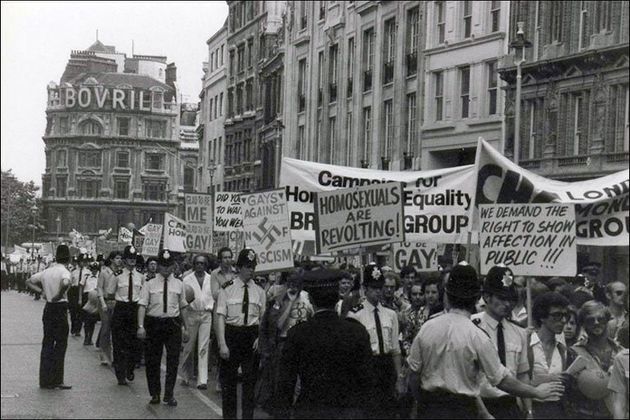
This Friday, it is fifty years to the day since the Stonewall Uprising, the night that changed everything for LGBT+ people around the world. It’s not something you’ll have been taught about in school – in fact many even in our own community won’t have heard of it.
On 28 June 1969, members of the LGBT+ community at the Stonewall Inn in New York stood up to decades of police oppression, sparking a series of events leading to the first ever Pride march through the city. The Gay Liberation Front organised that first march, and its members soon made their way across the pond to London the following year, where I quickly signed up.
Two short years later I found myself standing in Trafalgar Square, preparing to march in London’s first Pride rally. The weather on Saturday 1 July 1972 was warm and dry, and the atmosphere was electric – a mixture of nervous anticipation but also joyous camaraderie. Very few people were “out” back in those days – homosexuality was still very much frowned upon, even after being partially decriminalised in 1967. But we were determined to make ourselves visible and demand LGBT+ liberation, no matter if that meant putting ourselves at risk.
A good few hundred people came along to march in the end, though many were nervous about showing their faces. And not without good reason – you might be spotted by family members, or work colleagues. Back then, being a known homosexual was enough to get you the sack.
Of course, some closeted folk were there in the crowds lining the streets, perhaps silently wishing they could join us. I remember very clearly that a cop winked at us out of sight of his colleagues. Aside from that, the police presence was really quite intimidating, and I don’t know if they were there to deter us or protect us. At any rate, they obviously thought we were up to no good.
The debates about whether Pride is a protest or a celebration – or both! – continue to this day. The march was inherently political – we were taking back the streets, we were taking back the open air because our lives had been in the shade until then. But the atmosphere ended up being more like a carnival as we marched arm-in-arm down towards Hyde Park, stopping occasionally for the odd kiss.
In those days, two men kissing in public would be enough to get them arrested. Those were our acts of defiance though, and our entertainment. We didn’t have floats or sound systems or stages at the end of the march. And rather than being greeted by cheers, the response from the crowds was decidedly mixed – some of them had likely never seen a gay person in real life before.
The under-21s of the Gay Liberation Front who organised London’s first Pride march are now the under-70s and have children and grandchildren, great-nieces and great-nephews and great-non-binaries. How time flies! We did what we did to rescue ourselves, but we always thought of future generations – those who would come out after us, and will come out until the world ends.
But all these years later it’s clear that Pride is now more necessary than ever. Yes, some parts of our community enjoy certain rights that we were fighting for 50 years ago – but lesbian couples are still being attacked in public, trans people continue to face discrimination and abuse, and LGBT+ people still face injustice globally: it is clear that the fight is not yet won.
We have much to learn from the queer pioneers who came before us – including those who came well before me! – and we must take collective responsibility to understand our history. To help the generations of today take stock of how far we’ve come, those of us in the Gay Liberation Front have created a Souvenir Guide for Pride in London’s Pride Jubilee – containing letters, memories and moments from the past 50 years. We’ll be giving these out at the Pride in London Parade on Saturday 6 July, or alternatively you can pick one up at the Pride in London pop-up shop in Covent Garden.